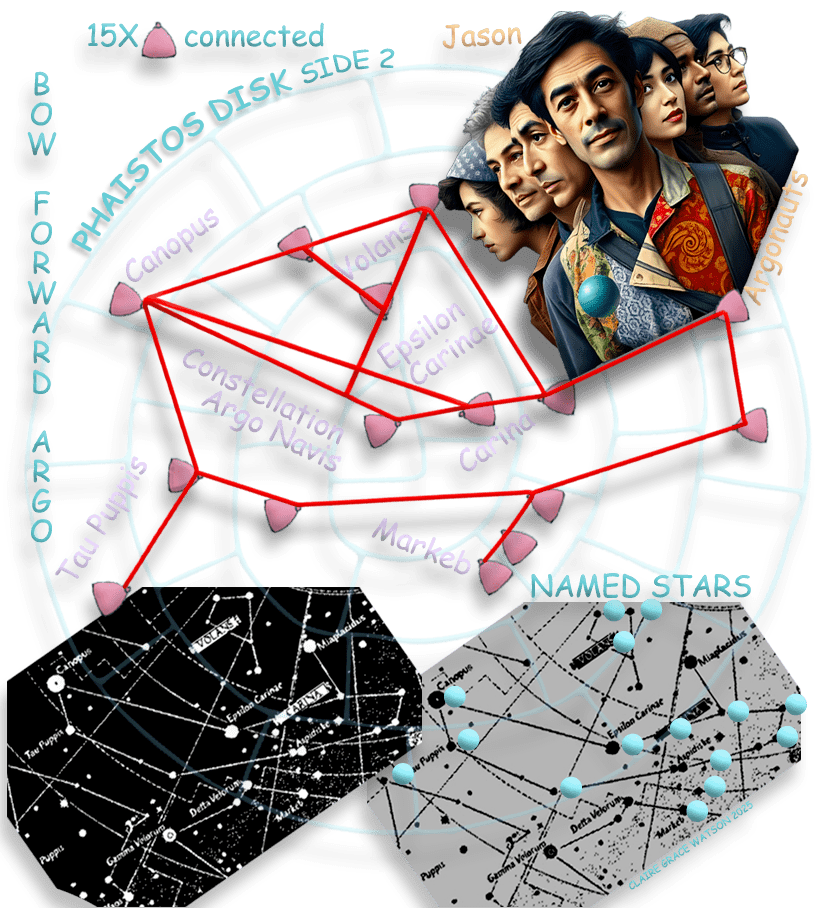
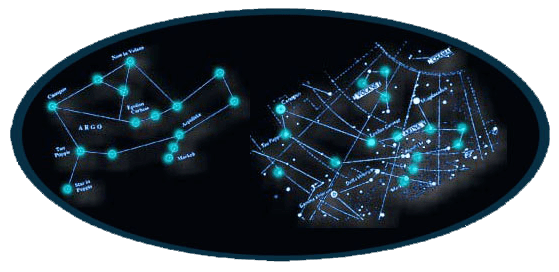
Jason and the Argonauts sailed the Argo about 600 years after the wave-tossed Argo on the Phaistos Disk that is not drawn backwards because it is the original version, logically sailing bow-forward. It has been sailing illogically stern-forward on constellation maps for the last 2,300 years, thanks perhaps to Johannes Hevelius' constellation map of 1642 CE, influenced by Aratos (310-245 BCE), who famously wrote:
"Sternforward Argo by the Great Dog's tail
...The whole symbolic evocation rests upon the supposed, and in the end actual, correspondence of things, on the relationship between microcosm and macrocosm as intuitively understood by the mind and visually by the eye... (Introduction, The Gods and Symbols of Ancient Egypt, Manfred Lurker, Thames and Hudson, publishers, 1974.)
We know about the Khufu Ship because it was excavated in modern times, but could the Minoans have known about the Khufu Ship in 1600 BCE while it was still buried? Perhaps it was part of their mythology involving the Great Pyramid. This pictograph
The Khufu ship is an intact full-size vessel from Ancient Egypt that was sealed into a pit in the Giza pyramid complex at the foot of the Great Pyramid of Giza around 2500 BC....The history and function of the ship are not precisely known.
Is drawn; for hers is not a usual course,
But backward turned she comes, as vessels do
When sailors have transposed the crooked stern
On entering harbour; all the ship reverse,
And gliding backward on the beach it grounds.
Sternforward thus is Jason's Argo drawn.
Minoan astronomers would have a laugh! 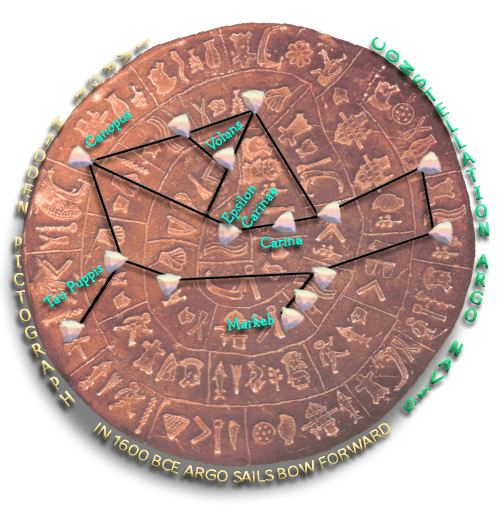
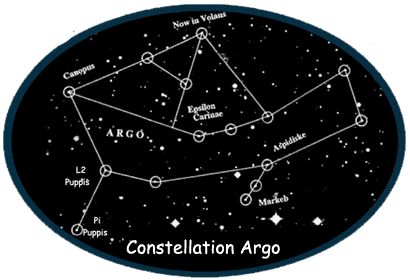
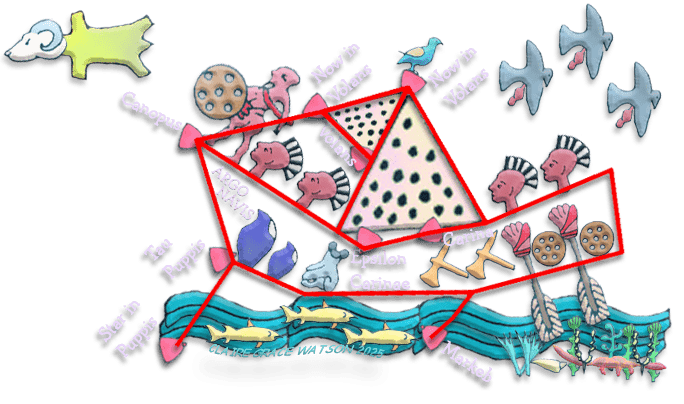 Jason and the Argonauts pursue the Golden Fleece, composed entirely of Phaistos Disk PictographsIs the Argo also the Khufu Ship?
Jason and the Argonauts pursue the Golden Fleece, composed entirely of Phaistos Disk PictographsIs the Argo also the Khufu Ship?![]() , along with the larger, hidden constellation Argo pictograph on the Disk (above), seems to imply knowledge of it. (The Boat/Argo pictograph could mean, "Beneath the Pyramid is a boat.") These ancient people considered the correspondences of things to be revelatory, so they would elevate to divine status a pictograph that reprsents a boat, a ferry, a constellation, a journey, a pyramid with a boat beneath it.
The Mystery of the Khufu Ship
, along with the larger, hidden constellation Argo pictograph on the Disk (above), seems to imply knowledge of it. (The Boat/Argo pictograph could mean, "Beneath the Pyramid is a boat.") These ancient people considered the correspondences of things to be revelatory, so they would elevate to divine status a pictograph that reprsents a boat, a ferry, a constellation, a journey, a pyramid with a boat beneath it.
The Mystery of the Khufu Ship![]()
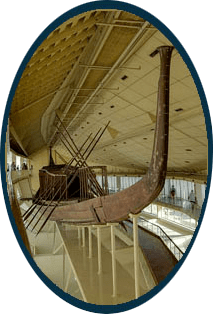
Is it possible the Great Pyramid and the Khufu ship together represent the constellation Argo as shown above on the Phaistos Disk (below, right)? Perhaps the idea behind the construction of the pyramid and the ship was to mirror the constellation on earth because it was the ancient Egyptians' idea of the location of "heaven" and also their method of the afterlife journey in traveling there. In Egyptian hieroglyphic writing, the triangular face of the pyramid is the hieroglyphic for star Sirius in the constellation Canis Major.
Sirius is the brightest star in the sky because of its proximity to our solar system. Sirius is the location of the Ogdoad, the eighth sphere, their concept equivalent to our idea of heaven. Perhaps this is where our symbol for infinity originally comes from, and the Phaistos Disk also corresponds to that idea of the Ogdoad and represents it, with its eight spheres and its continuum concept. Turned on its side it becomes the modern symbol for infinity.
Seen at the prow of the Argo pictograph is the pilot, the star 'Kanobus' (Canopus), or 'Pilot'-- from whom, they say, the star got its name." (Plutarch in Thrice-Greatest Hermes, G.R.S. Mead) Osiris is the General and Kanobus is the Pilot. Canopus is the second brightest star in the sky after Sirius. Perhaps a person might make the afterlife journey in the Khufu ship to Argo to become one of the immortal oarsman in this ship, and from this came the mythology of Jason and the Argonauts, the idea being to take a place in the boat, take up the oar and become one of the Argonauts after death.
This way of thinking, this idea of the afterlife world being located in a constellation, may seem foreign to us because of our distance in consciousness from the ancient Egyptians, but from this way of thinking comes our idea of heaven as being "up there" in the stars. Also, their idea of the world below as a mirror image of the world above may have been based on their ideas regarding geometry. One of those ideas was the concept of:
"Duat, the realm of the dead. The Duat is the realm of the [good] god Osiris and the residence of other gods and supernatural beings. It is the region through which the sun god Ra travels from west to east during the night [in his evening boat], and where he battled [evil] Apep [Lord of Chaos}. It also was the place where people's souls went after death for judgement, though that was not the full extent of the afterlife. Burial chambers formed touching-points between the mundane world and the Duat, and spirits could use tombs to travel back and forth from the Duat."
Could the air shafts in the Great Pyramid be tunnels created to assist the souls in traveling back and forth from the Duat? This could explain the necessity of their alignment with certain stars, the stars representing specific realms of the Duat. The Great Pyramid would therefore not be a tomb but a massive spiritual technology based on the Sacred Science and beliefs regarding how the soul navigates in the afterlife to its natural destination -- the constellation realm of the gods. This would explain why no Pharaoh was found buried there, making the so-called coffin in the pyramid only symbolic rather than functional. It is a tomb for souls, rather than bodies, used by the priest caste and the pharaohs, its design based on the Sacred Science to assist travel back and forth between the realms. Perhaps these ancient people perceived the constellation Argo/Khufu Ship as a vehicle of travel between these worlds.
This would be a remarkable "Science of the Afterlife." Where we have faith alone regarding the afterlife, they developed an entire science around it and implemented their ideas with geometry because that was part of their religion -- their Sacred Science.
The spiritual world of the ancient Egyptians is not immediately understandable by the western civilizations of the twentieth century...We may find it ridiculous for artists to represent the sky as a cow, or for a beetle to be venerated as a symbol of the sun god, but in past ages, among peoples having a mythical view of the world, the formative principle was not of logic but of an outlook governed by images...The whole symbolic evocation rests upon the supposed, and in the end actual, correspondence of things, on the relationship between microcosm and macrocosm as intuitively understood by the mind and visually by the eye...The ancient Egyptians, the Babylonians, and to some extent the Greeks, used images; their view of the world was a comprehensive one. (Introduction, The Gods and Symbols of Ancient Egypt, Manfred Lurker, Thames and Hudson, publishers, 1974.)
...A symbol has manifold significance and therefore its origin and purpose cannot often be explained satisfactorily. Sometimes the symbol seems to contradict itself. There are, in fact, symbols which refer to both poles of existence: life and death, good and evil. (Introduction, The Gods and Symbols of Ancient Egyptx, Manfred Lurker, Thames and Hudson, publishers, 1974.)
Lo! I am Khepera at dawn, Ra at high noon, and Tum at eventide.  We may not understand why they thought like this but we still retain vestiges of what they thought, and this becomes one of our connections to them though they seem lost in time from us. Regardless the distance in space and time between us, we share the commonality of a rational mind that intuitively looks for patterns as a way of identifying and comprehending things.
If we can find the patterns in chaos, then are we not followers in the mighty footsteps of the sun god Ra and is not Apep, the dark Lord of Chaos, defeated? We seek to find a larger pattern, evidence that our lives are patterned on a higher dimension, an immortal and eternal realm to which we may return.
We may not understand why they thought like this but we still retain vestiges of what they thought, and this becomes one of our connections to them though they seem lost in time from us. Regardless the distance in space and time between us, we share the commonality of a rational mind that intuitively looks for patterns as a way of identifying and comprehending things.
If we can find the patterns in chaos, then are we not followers in the mighty footsteps of the sun god Ra and is not Apep, the dark Lord of Chaos, defeated? We seek to find a larger pattern, evidence that our lives are patterned on a higher dimension, an immortal and eternal realm to which we may return.
In fact, an entire concept of this came through during early common era Gnosticism, regarding the necessary passwords one would need when making this return journey, the soul no longer needing the boat ferry. Gatekeepers and Passwords
According to ancient history regarding these people, passed down to us as mythology, a mix of fact and fiction, the original Cretans or "Curetes" were Argonauts (Sailors of the Argo). They were the Minyae, the five immortal Curetes also called Dactyls, collectively Dactyloi, meaning fingers, who established the Minoan civilization. Exactly five "Dactyl/Glove" pictographs appear on the Phaistos Disk perhaps representing these five immortal Curetes or Cretans. Perhaps the rope truss tattoo symbolizes the sailor's lineage as descendant of the Argonauts and one of the five original Curetes/Dactyloi. Beside the "Glove" appears to be the "Golden Fleece" pictograph (above, 4), eternally sought for by the Argonauts sailing the night skies in the Argo. The fleece belonged to the golden haired ram (5), possibly the pictograph for Aries on the Phaistos Disk. Aries was anciently associated with the sun god Ra.
How did Cretans and Egyptians communicate? Did the Minoans speak Egyptian? Did the Egyptians speak Minoan? Is this picture writing found on the Phaistos Disk part of a specific nautical language used exclusively by the Minoans and the Egyptians in their communications? This might explain why it is found nowhere else and why it was not preserved by the Egyptians, who had their own written language.
The Rope Truss:
Nautical Tecnology in the Bronze Age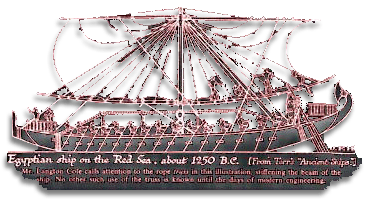
 The rope truss was a unique nautical technology advancement of the Bronze Age, used to stiffen the beam of the ship (above at the base of the beam in the shape of a figure 8). No other such use of the truss is known until the days of modern engineering. Does this pictograph (below, left, 1) show a sailor with a rope truss tattoo on his cheek or is that a clue to the solution of the puzzle of the disk? Perhaps it is both. Beside him are pictographs that could be his oar (2) and his glove (3) for rowing.
The rope truss was a unique nautical technology advancement of the Bronze Age, used to stiffen the beam of the ship (above at the base of the beam in the shape of a figure 8). No other such use of the truss is known until the days of modern engineering. Does this pictograph (below, left, 1) show a sailor with a rope truss tattoo on his cheek or is that a clue to the solution of the puzzle of the disk? Perhaps it is both. Beside him are pictographs that could be his oar (2) and his glove (3) for rowing.
![]()


![]() Dodona
Dodona
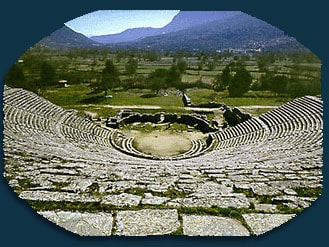
 The Argos of mythology was built at Dodona, where an ancient sanctuary of Zeus was located. A stadium was built there in the 3rd century B.C., open like a sunflower to hold 18,000 people. (far left and "flower" from disk) Dodona also had several temples, a theater, a stadium, and an acropolis, including a Temple of Heracles. Was Dodona the site of the first Olympic Games?
The Argos of mythology was built at Dodona, where an ancient sanctuary of Zeus was located. A stadium was built there in the 3rd century B.C., open like a sunflower to hold 18,000 people. (far left and "flower" from disk) Dodona also had several temples, a theater, a stadium, and an acropolis, including a Temple of Heracles. Was Dodona the site of the first Olympic Games?
![]() Dodona was the oldest oracle, sacred to Zeus and Dione. An old oak tree there became an oracle when a black dove, from Egyptian Thebes, settled on it. Priestesses interpreted the rustling of the tree's leaves, the cooing of doves, and the clanging of brass vessels that were hung from the tree's branches. At Dodona, they spoke in images - symbols - not words. Does the Phaistos Disk preserve part of their symbol language?
Dodona was the oldest oracle, sacred to Zeus and Dione. An old oak tree there became an oracle when a black dove, from Egyptian Thebes, settled on it. Priestesses interpreted the rustling of the tree's leaves, the cooing of doves, and the clanging of brass vessels that were hung from the tree's branches. At Dodona, they spoke in images - symbols - not words. Does the Phaistos Disk preserve part of their symbol language?
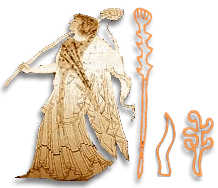 Also in Dodona were the Oreiades, (right) divine children of the Dactyloi and cousins of the dancing Curetes. They were nymphs of the mountain oaks (1) and pines. They were usually portrayed with serpents (2), and they carried thyrsoi, pine-cone tipped staves or poles. (3) Thyrsoi were symbolic wands, generally cane-like or knotted like a bamboo, and sometimes wreathed with ivy or vine leaves, with a pine-cone at the top. (Plutarch)
Also in Dodona were the Oreiades, (right) divine children of the Dactyloi and cousins of the dancing Curetes. They were nymphs of the mountain oaks (1) and pines. They were usually portrayed with serpents (2), and they carried thyrsoi, pine-cone tipped staves or poles. (3) Thyrsoi were symbolic wands, generally cane-like or knotted like a bamboo, and sometimes wreathed with ivy or vine leaves, with a pine-cone at the top. (Plutarch) ![]()
![]()
![]()
![]() The Argos (1) was made of sacred oak (2) from the oracle at Dodona. The Argonauts were sailing the Aegean Sea (3) searching for the golden fleece (4) belonging to the ram (5) that had been sacrificed to Zeus.
The Argos (1) was made of sacred oak (2) from the oracle at Dodona. The Argonauts were sailing the Aegean Sea (3) searching for the golden fleece (4) belonging to the ram (5) that had been sacrificed to Zeus. ![]()
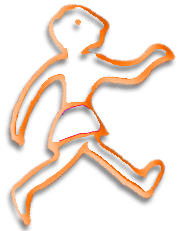
![]() Herakles and his brothers, the five original Curetes, are said to have built the alter of Olympic Zeus (1) and to have begun the Olympic games with a foot race, (2) which Herakles won. He received as his prize a branch of the wild olive. (3) PagemapBookmap
Herakles and his brothers, the five original Curetes, are said to have built the alter of Olympic Zeus (1) and to have begun the Olympic games with a foot race, (2) which Herakles won. He received as his prize a branch of the wild olive. (3) PagemapBookmap![]()
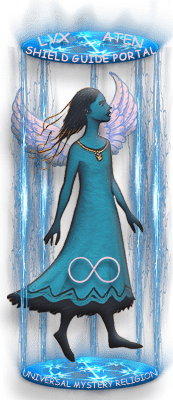 Copyright Notice - Disk of the World - Text and images copyrighted March 21, 1993-2025, Claire Grace Watson, B.A., M.S.T., U.S. Copyright and under the Digital Millennium Copyright Act of 1998, All rights reserved. No part of this web page may be reproduced or transmitted in any form or by any means without written permission from the author, except for the inclusion of brief quotations in a review.
Copyright Notice - Disk of the World - Text and images copyrighted March 21, 1993-2025, Claire Grace Watson, B.A., M.S.T., U.S. Copyright and under the Digital Millennium Copyright Act of 1998, All rights reserved. No part of this web page may be reproduced or transmitted in any form or by any means without written permission from the author, except for the inclusion of brief quotations in a review.